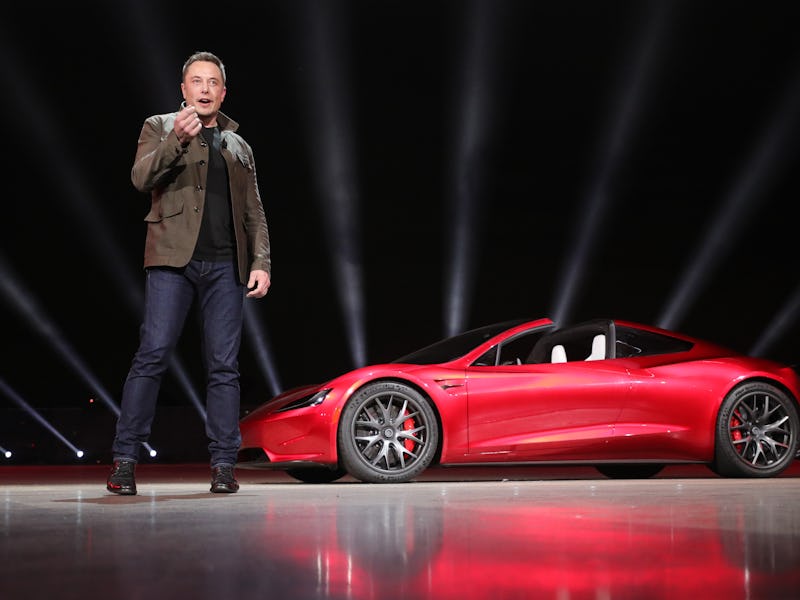Tesla Roadster release date: Elon Musk talks rocket add-ons and launch plan
The Tesla CEO described the car as "tak[ing] some things...from rocket world."

The Tesla Roadster, the heavily hyped all-electric supercar, is set to stun – but it could take until sometime after 2021 to hit roads.
Elon Musk explained in detail last week how the company plans to impress fans by "do[ing] some things that are unfair" and "tak[ing] some things from rocket world." During an appearance on The Joe Rogan Experience, the Tesla CEO detailed how the high-performance car will impress more than expected:
With the Roadster, we're going to do some things that are kind of unfair. We're going to take some things from rocket world and put them on a car. [...] Like I said, we can't do the product unveil right here, but it's going to do some things that are unfair. When do we do unveil the Roadster, let me just say that anyone who's been waiting, they won't be sorry. They won't be sorry.
It's a big promise for the highly-anticipated vehicle. At a starting price of $200,000, the Roadster is aimed at a far more niche market than the likes of Model 3, Model Y and Cybertruck, all of which start below $40,000. The Roadster, unveiled in November 2017, is set to offer 0 to 60 mph acceleration times of 1.9 seconds, battery range of 620 miles, and a top speed of over 250 mph.
"Rocket world" looks set to contribute in a big way. At the June 2018 shareholder meeting, Musk first announced a SpaceX options package. Musk later explained that it would involve 10 small thrusters placed around the car, designed to "dramatically improve acceleration, top speed, braking & cornering," and perhaps "even allow a Tesla to fly." The thrusters would use ultra high-pressure air from a COPV bottle taking up the two rear "kid seats."
Unfortunately, those looking for a speedy release for the speedy car will likely be disappointed. During the same podcast appearance, Musk said that "I think we should do Cybertruck first before Roadster," hinting at a release sometime after late 2021 when the first Cybertrucks are expected to hit roads.
It's a noticeable delay from the original unveiling when it was suggested the car would hit roads in 2020, but Musk explained that the Roadster depends on new technologies further down the line:
Some of the things for Roadster, the tri-motor Plaid powertrain, we're going to have that in Model S. So that's one of the ingredients that's needed for Roadster, is the Plaid powertrain, more advanced battery pack, that kind of thing.
The Plaid powertrain, the new version of the system that powers the car, has impressed onlookers in its early tests. A Plaid version of the Model S set a lap time on the Nurburgring in September 2019 of seven minutes and 23 seconds, 19 seconds faster than Porsche Taycan. The new powertrain is set to reach the Model S toward the end of this year, followed by the Model X and second-generation Roadster.
Something you probably won't see for a while: a Roadster going for a ride.
It may take a while before a Roadster release date becomes clear. As Musk explained during the interview:
I can't say exactly when, but...this Covid thing's kind of thrown us through a loop. Not to blame everything on Covid, but it certainly set us back on progress for some number of months. Things we've got to get done ahead of Roadster are ramping up Model Y production. That'll be a great car. It is a great car. Getting the Berlin Gigafactory built and also building [Model] Y. Expanding the Shanghai Gigafactory which is going great. Get the Cybertruck, Semi truck. Roadster...Roadster's kind of like dessert. We've got to get the meat and potatoes and greens.
The Inverse analysis – The Roadster has always been seen as a low-quantity vehicle, more designed to make a statement than seriously influence the company's financial results. Musk suggested in the June 2019 earnings call that Tesla would be unlikely to build more than 10,000 Roadsters per year, compared to around 5,000 per week for the Model 3 alone. With the car itself in short supply even when production starts, it seems the Roadster may take a backseat when it comes to getting more people onto electric cars.